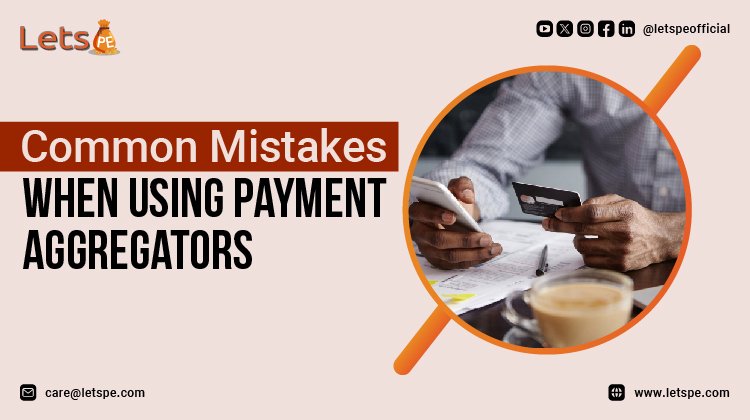Avoiding Pitfalls: Common Mistakes When Using Payment Aggregators
Running a business in this digital age means you have to get payment processing right or else you'll run the risk of losing customers and profits.

Those days are gone when cash was Supreme. In today's digital realm, more than 63% of consumers concede to seldom using cash to make any purchase.
Running a business in this digital age means you have to get payment processing right or else you'll run the risk of losing customers and profits. However, this important business system is also pierced with pitfalls. Each year, failed transactions cost the global economy an astonishing $123.3 billion, so you must do what you can to avoid contributing to these worrying statistics.
Setting up a flawless payment solution for your website or application is a challenging feat. However, hesitancy with payment processing means revenue loss and creates customer disappointment. Today we'll know the most common payment processing pitfalls and tips to avoid them through this article. Practise these best practices and make sure seamless transactions delight your customers.
Not Preferring the Right Payment Solution

Picture a scenario - it's Sunday, the India vs Pakistan match is going on and your online store is fuzzing many people who are ready to buy. But your clumsy payment solution keeps glitching. Transactions are collapsing from left to right. You're weeping sales by the minute. Not a great scene, is it?
Don't stuck up in the hurdle. Your payment solution is the backbone of your business. Examine those vendors carefully. Examine things like rates, contract terms, integrations, reporting, security and dispute resolution. If you can, take demos of payment Aggregator. It helps you to check how's good the checkout experience.
Choosing the right payment solution partner takes work but pays off with smoother operations. You want customers to fly through checkout rather than get irritated.
Not Securing the System

Your payment platform keeps confidential customer data - names, addresses, and card details. One miniature breach of data may wipe out your reputation, not to mention substantial penalties.
Follow standard protocols such as end-to-end encryption, tokenization, and complex authentication. If this seems too hard, see if you can work closely with your provider to execute it. Go beyond guessable passwords. Update software regularly. Monitor activity carefully to detect fraud at the same time.
Instead of treating security as an afterthought, you have to make it a central pillar of your business right from the start, conveying equal value as quality and customer service. Taking bold measures to safeguard customer data is key to gaining their trust and confidence in your brand.
Not Testing Before Launch

After investing valuable time and assets into integrating the new payment solution, the natural appeal is to direct customer transactions to the new system ASAP. However, eluding thorough testing before launch can cause major issues down the line that affect customer experience, revenue, and brand reputation.
Before roaming real customer payments, comprehensively test across a wide range of scenarios, transaction types, devices, and platforms. Check that error messaging, failover mechanisms, and email receipts function properly in all conditions.
Also Read: The Pros and Cons of Using a Payment Aggregator for Your Business
Examine the testing through the point of view of your customer’s experience to determine potential aching points or confusing flows. This attentive testing may delay your launch date but will pay bonuses by escaping frustrated customers, dropping sales, and public errors occur when real money is at stake.
Not Observing Operations Closely

The work does not stop once your payment processing solution goes live. Ongoing monitoring and optimization are important to reduce friction and chargebacks. Rather than taking an impressible approach and troubleshooting issues as they arise, carefully track key performance indicators across transaction volume, common errors, processing times, and dispute rates.
Analyze the data with an eye toward spotting patterns, hindrances, and opportunities for improvement. Implement real-time alert systems to detect problems at the first sign rather than after escalation. You should also consider automating resolution through APIs to computing software.
Once again, look at every payment failure from the customer’s perspective and try to remove friction and confusion before customers take their business elsewhere. View payment operations as a digital experience requiring constant elegance, not a set-it-and-forget-it infrastructure.
Not Staying Updated with Current Compliance Standards
The payments industry is emerging rapidly, with new regulations emerging constantly. A one-year-old complaint may now expose you to penalties or legal risks. Staying updated with current standards is a top priority.
As for the here and now, make sure you take the time to regularly review your systems and policies to make sure they align with the latest rules on data protection, security protocols, and many more. If you need to, deploy compliance checks to experts so you can have peace of mind aware that you are completely up to date.
Also Read: Choosing the Right Payment Aggregator: A Step-by-Step Guide
While staying compliant takes work, it creates customer trust and prevents expensive penalties down the road. The cost of casual compliance is far greater than staying driven about integrating required changes. Don't risk fines or charges that could ruin your business.
Closure
When it comes to payment processing, a small error can be costly. The key is finding the right buddy, testing rigorously, taking security seriously, monitoring data, and staying up-to-date on the regulations. Do all that, and you will be in good structure.
Customers will whiff through checkout as your revenue keeps growing without technical glitches. In addition, you'll be relaxing easily knowing your systems are locked up tight. So be thorough, be watchful, and don't cut sections. Consider these tips, and your payment operations will be smooth as silk.

 letspe_admin
letspe_admin 










